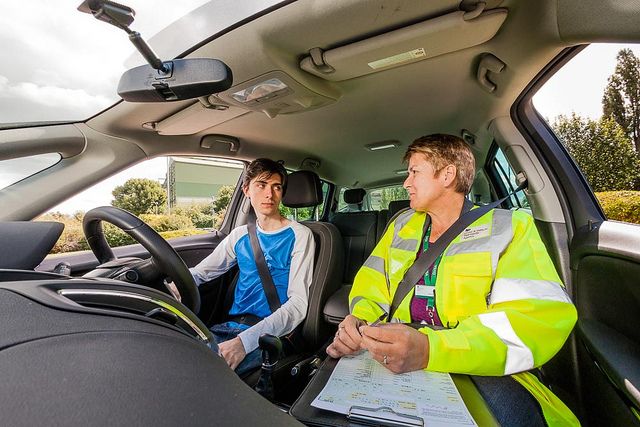Home > ADI Part 2 > Faults and test result
SEE OUR PAGE ADI PART 2 MARKING SHEET EXPLAINED
There are 3 types of faults you can make:
- a dangerous fault - this involves actual danger to you, the examiner, the public or property
- a serious fault - something potentially dangerous
- a driving fault - this is not potentially dangerous, but if you keep making the same fault, it could become a serious fault
Pass mark
You’ll pass your approved driving instructor (ADI) part 2 test if you make:
- no more than 6 driving faults
- no serious or dangerous faults
ADI Part 2 -Common faults and Test Results

TOP 10 Reasons for Failing the ADI Part 2 driving test
Junctions: observation
You’ll be marked with this fault for not taking effective observation before emerging at junctions and emerging into the path of other vehicles. Always make sure it’s safe before proceeding.
Mirrors: change direction
Remember that you need to use your rear-view mirror and wing mirrors – and react to the information they’re giving you! People get caught out for changing direction and pulling up with no mirror checks, increasing their speed with no mirror checks, or using their mirrors too late.
Control: steering
You need to be able to maintain a steady course in normal driving. Things like mounting and dismounting the kerb, and not following the contour of the kerb results in faults in this area.
Junctions: turning right
When you’re turning right, position your vehicle correctly – it should not cut the corner when turning right. Also, watch out for cyclists and motorcyclists, and any pedestrians crossing the road.
Move off: safely
Using your mirrors to check for other road users is essential. It’ll be marked as a fault if you attempt to move off without doing so. Not checking over the right should blindspot is also a serious fault!
Response to signs: traffic lights
Giving the right response to traffic lights is something that catches people out. Some of the mistakes that people make include waiting at a green filter light when it’s safe to proceed and staying at the stop line when it’s safe to move. Other faults that count include not conforming to a red light and stopping beyond an advanced stop line in the area designated for cyclists.
Move off: control
Repeated stalling is one of the things that counts as control when moving off. Other things that are included in this reason are moving off (or trying to!) with the handbrake on, rolling backwards when trying to move off – and not putting the car in gear and attempting to move off.
Positioning: normal driving
Your vehicle should be positioned correctly for the route you’re taking. If lanes are marked, make sure you’re in the middle of the lane. Avoid straddling lanes.
Response to signs: road markings
You’ll be marked with faults in this area for doing things like unnecessarily crossing the solid white centre lines on the road, and not following directional arrows. Stopping in a yellow box junction when the exit is not clear also counts for this reason. So, make sure you know the rules about using them.
Reverse park: control
In the driving test, you can be asked to either do a parallel park on the road or reverse into a parking bay at the test centre.
You’ll notch up a fault in this area if you need to reposition to correct a loss of control or accuracy. A complete misjudgement or significant loss of control will count as a serious fault.
If you do not pass
The examiner will tell you what faults you made.
You can take the test again if you fail at either your first or second attempt.
You have to book another test and pay again.
Failing the third attempt
You have to retake and pass the ADI part 1 test again if you fail the ADI part 2 test 3 times.
You have to wait 2 years from when you first passed the ADI part 1 test before you can take it again.
Appeal your ADI part 2 test
You can appeal if you think your examiner did not follow the regulations when they carried out your test.
Your test result cannot be changed, but you might get a free retest if your appeal is successful.
How to appeal
You have to appeal to a magistrate’s court or sheriff’s court.
You must appeal to a:
- magistrate’s court within 6 months if you took your test in England or Wales
- sheriff’s court within 21 days if you took your test in Scotland
Here are the top three reasons for failing the part 2 test.
3) Picking up a serious fault, especially by not making enough progress.
Imagine that you’re approaching a roundabout and the left lane, which goes ahead, has five vehicles in it. The middle lane, which also goes ahead, is empty. If a learner was to choose the left hand lane then it wouldn’t be a problem. If you did that on a part two then you would fail for not making sufficient progress by overtaking the other vehicles.
2) An accumulation of faults. You can only make 6 faults during the one hour drive. It’s very often the case that people fail due to picking up too many small faults rather than a single serious fault.
An example of a small fault would be if the car is jumping when you’re stopping. Harsh braking shows poor planning and will be marked down; one of the key elements of advanced driving and an essential skill you must pass on to learners.
A very common mistake made on part 2 is signalling when it’s not necessary. If you indicate to pull up and move off but nobody is around to see the signal then what is the point of signalling? Do this on an L test and it wouldn’t matter. You’d fail a part 2 for signalling unnecessarily.
1) You’ll learn what the most common fault is on your training.
